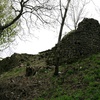Castle of Dalli di Sopra
The town of Dalli di Sopra is at 997 metres above sea level along the hill on the eastern side of Mount La Corona in a position to dominate the entire initial part of the Serchio Valley of Sillano. This central location was closely related to a series of fortified complexes built on the surrounding hills, now disappeared altogether or only partially preserved, such as that of Mount Il Torrione, Fort Cogna or Sillano.
Today, the structure of Fort Dalli is detectable in the urban layout of the small centre, with a circular form to the west probably following the pattern of the ancient castle walls. The agglomeration outside this first circuit of these walls clearly appears as an extension from a later period. The only part of the ancient fortress that survives is the west curtain wall and a related semi-circular tower (dating no earlier than the 13th century).
The Sanctuary of Our Lady of Perpetual Help is well worth a visit. Here conserved are several particularly interesting works of art, among which a stone altar dating from the 17th century and a panel painting depicting the Madonna and Child, dating from 1475-1490 and signed by the painter Pietro di Talata.
Historical notes
The settlement of Dalli was the subject of on-going struggles over the centuries. After being assigned as a fiefdom to the nobles of the town, due to ties with Malaspina and the Countess Matilde of Canossa the castle was damaged during the wars waged by Lucca between the 12th and 13th centuries. In 1299 the nobles of Dalli sold the castle to the Lucchesi along with their fiefdom and all other privileges, even if the noble family continued to live on their old estates.
In 1396, as a result of the insubordination of Bartolomeo Martinelli, warden of Dalli, the brigades supported by Pisa managed to enter the fortress almost without a shot being fired. As soon as the Republic of Lucca regained the fortress, it wanted to give a tangible sign of how they punished rebels and traitors, and so in addition to burning down the villages of Dalli, Sillano and Soraggio, they immediately razed the fortress to the ground, as documented by Giovanni Sercambi in his chronicles.









